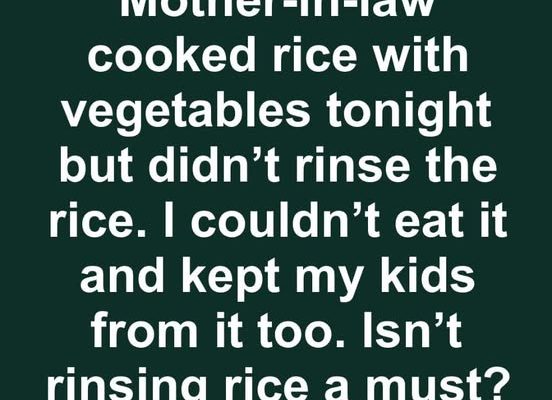Rinsing rice before cooking is one of those kitchen debates that has people split down the middle. For many, it’s as automatic as preheating an oven before baking. But for others, skipping this step is a matter of tradition, convenience, or simply a belief that it’s unnecessary. When it comes to rice, opinions run deep, and the topic of whether rinsing is truly essential has sparked countless conversations, like the one about a mother-in-law who cooked rice without rinsing it, leaving her family hesitant to eat it. So, is rinsing rice a non-negotiable step?
Why Rinsing Rice Feels Like a Must for Many

For those who swear by rinsing rice, it’s not just a chore—it’s an essential part of the cooking process. The primary reason? Cleanliness. Rinsing removes excess starch, which can make the rice overly sticky or gummy when cooked. It also helps get rid of any dust, debris, or impurities that might have clung to the rice during packaging and transport.
Another reason is texture. Fluffy rice with distinct grains often requires rinsing to eliminate the surface starch that causes clumping. This is especially important for dishes like pilafs or fried rice, where individual grains are key to the dish’s appeal.
But for some, rinsing rice isn’t just about function—it’s about honoring culinary traditions passed down for generations.
Why Some People Don’t Rinse Their Rice
On the flip side, there are plenty of households where rinsing rice isn’t part of the routine. Why? One reason could be cultural traditions. In certain cuisines, rice preparation doesn’t emphasize rinsing, especially when dealing with enriched or fortified rice.
Modern rice processing methods also play a role. Many people believe that rice sold today is already clean and doesn’t need an additional rinse. Some even argue that rinsing enriched rice removes the nutrients that are added during fortification, which defeats the purpose of choosing fortified grains in the first place.
Convenience is another factor. Let’s face it: rinsing rice can feel like an extra step, especially on busy nights when you’re just trying to get dinner on the table.
The Science of Rinsing: What’s Really Happening?
Here’s where things get technical. Rinsing rice serves two main purposes: removing starch and clearing away impurities.
- Excess starch: When rice is milled, grains can rub against each other, creating a fine layer of starch. If you cook rice without rinsing, that starch dissolves into the water and creates a gummy texture. While this stickiness might work for sushi or risotto, it’s less ideal for fluffy basmati or jasmine rice.
- Impurities and residues: Depending on where and how the rice is processed, there may be traces of dust, pesticides, or other residues on the grains. Rinsing helps wash these away, providing peace of mind, especially for those who prioritize cleanliness in food preparation.
For those who skip rinsing, pre-packaged rice types like parboiled or pre-washed varieties might be the go-to choice, as these are less likely to contain impurities.
The Health Concerns: Is It Unsafe Not to Rinse Rice?
Not rinsing rice isn’t inherently dangerous, but it could carry some minor risks. While most commercial rice is processed in hygienic conditions, traces of dust, dirt, or even pesticides can sometimes remain on the grains.

For families, especially those with young children, the idea of potential contaminants might be enough reason to rinse. Even if the health risks are minimal, the peace of mind that comes from rinsing rice can make it worth the effort.
Cultural Perspectives on Rinsing Rice
Rinsing rice is deeply rooted in cultural practices, and these traditions shape how rice is prepared around the world.
In many Asian households, rinsing rice is non-negotiable. It’s often done multiple times until the water runs clear, symbolizing care and respect for the food. In Japanese cuisine, for instance, the rice-washing process (referred to as “togiru”) is almost ritualistic.
In contrast, Western cooking practices may not emphasize rinsing as much, especially when using pre-washed or enriched rice. This difference highlights how diverse and adaptable rice preparation can be.
Balancing Convenience, Health, and Tradition
The choice to rinse or not often comes down to personal priorities. Some prioritize the traditions they grew up with, while others focus on saving time or retaining added nutrients.
If you’re torn, consider the type of rice you’re using. Long-grain varieties like basmati or jasmine typically benefit from rinsing for a better texture, while pre-packaged, parboiled, or enriched rice might not require it.
It’s all about striking a balance. For some, rinsing rice is an expression of care and attention to detail. For others, it’s an unnecessary step that adds time to meal prep. Neither approach is “wrong.”
What About the Kids? Parental Concerns About Unrinsed Rice

For parents, the stakes feel higher. After all, feeding your kids means ensuring they get safe, healthy meals. If there’s even a slight chance that unrinsed rice could have impurities, many parents would rather rinse and err on the side of caution.
But beyond safety, there’s an educational aspect. Teaching kids about food preparation—including why rinsing rice is important—can instill good habits and an understanding of food hygiene.
So, Is Rinsing Rice Necessary?
At the end of the day, whether or not you rinse rice comes down to personal preference, cultural background, and the type of rice you’re cooking. If you value fluffiness, cleanliness, and tradition, rinsing is the way to go. If convenience or retaining nutrients in fortified rice matters more to you, skipping it is perfectly fine.
Whatever you decide, the key is to enjoy the meal—and maybe spark a lively conversation about it over dinner. After all, food isn’t just about sustenance; it’s about the stories and traditions we share along the way.
So, whether you’re rinsing rice until the water runs crystal clear or tossing it straight into the pot, the most important thing is to savor the experience.



